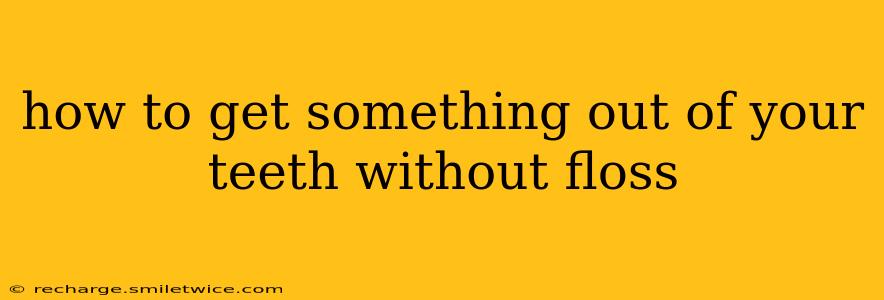Getting something stuck between your teeth is a frustratingly common experience. While floss is the ideal tool for this, there are times when you might not have any on hand. Don't panic! There are several alternative methods you can try to dislodge that pesky food particle or other debris. This guide will explore safe and effective ways to remove trapped items from between your teeth without using floss.
What to Do If You Don't Have Floss
Before we delve into the specifics, it's crucial to understand that while these alternatives can work in a pinch, flossing regularly is still the best way to maintain optimal oral hygiene. These methods should be considered temporary solutions.
1. Using a Toothpick
A toothpick can be a surprisingly effective tool for removing larger food particles. However, use it carefully!
- Technique: Gently insert the toothpick into the area where the food is stuck. Avoid excessive force, which could damage your gums. Use a gentle back-and-forth motion to dislodge the debris. Never force the toothpick between your teeth.
- Caution: Toothpicks can be sharp and can easily damage your gums if used incorrectly. Use a flat toothpick, if possible, and be extremely gentle. Disposable toothpicks are preferable to reusable ones due to hygiene concerns.
2. Using a Waterpik or Water Flosser
A waterpik uses a jet of water to remove food particles and plaque from between your teeth. It's a fantastic alternative to traditional flossing, especially for those with braces or sensitive gums.
- Technique: Simply direct the water jet to the area where the food is stuck. The force of the water should be enough to dislodge the debris.
- Benefits: Gentle yet effective, and can reach areas traditional floss might struggle with.
3. Using a Wooden Interdental Brush (Interdental Cleaner)
These small, brush-like tools are specifically designed to clean between teeth. They're available in various sizes, making them suitable for different sized gaps.
- Technique: Gently insert the brush between your teeth and use a back-and-forth motion to dislodge the food particle. Ensure to use the appropriate size for your gaps.
- Benefits: Better than toothpicks as they are designed for interdental cleaning.
What NOT to Do
Some methods might seem tempting but are highly discouraged:
- Using a pin or needle: These are extremely dangerous and can cause serious damage to your gums and teeth. Avoid these at all costs.
- Using your fingernail: While tempting, this can introduce bacteria and potentially damage your gums.
- Ignoring it: Leaving food trapped between your teeth can lead to cavities, gum disease, and bad breath.
How to Prevent Food from Getting Stuck in Your Teeth
Prevention is always better than cure! Here are a few tips:
- Proper Chewing: Chew your food thoroughly to break it down into smaller pieces.
- Regular Dental Checkups: Regular visits to your dentist help identify any potential issues early on.
- Consistent Flossing: As previously mentioned, flossing is the best way to prevent food from getting stuck in your teeth. Make it a part of your daily oral hygiene routine.
Frequently Asked Questions
What if I can't get it out?
If you've tried these methods and the food particle is still stuck, it's best to schedule an appointment with your dentist. They have the tools and expertise to safely remove the object and assess your oral health.
Can leaving food stuck in my teeth cause problems?
Yes, leaving food trapped between your teeth can lead to cavities, gum disease, and bad breath. It provides a breeding ground for bacteria.
Are there any long-term solutions to prevent this?
Regular flossing and brushing, combined with a balanced diet and regular dental checkups, are the best long-term solutions. Consider using interdental brushes for cleaning those tighter spaces.
Remember, while these alternatives can help in a pinch, consistent flossing is the key to maintaining healthy teeth and gums. If you have concerns about your oral health, consult a dentist for personalized advice.
